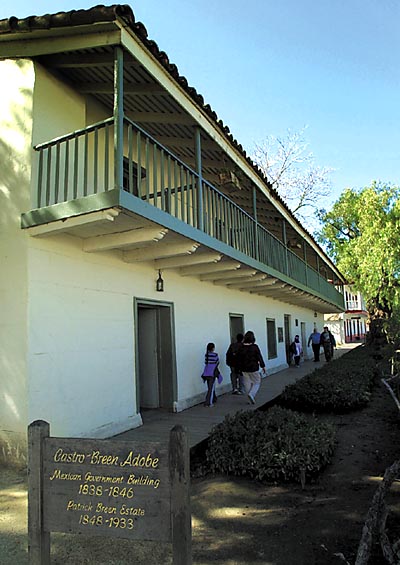
To help calm the uproar over the $1.6 million rehabilitation of
the Castro-Breen Adobe, representatives of the California State
Parks Department Tuesday presented what the future holds for the
historic building.
Speaking before the San Juan Bautista City Council, Don Amos,
exhibit designer for the Northern Service Center, said the
Castro-Breen Adobe project originated in 1985 and because of the
Loma Prieta Earthquake in 1989 a number of adobes across the state
were assessed and evaluated.
To help calm the uproar over the $1.6 million rehabilitation of the Castro-Breen Adobe, representatives of the California State Parks Department Tuesday presented what the future holds for the historic building.
Speaking before the San Juan Bautista City Council, Don Amos, exhibit designer for the Northern Service Center, said the Castro-Breen Adobe project originated in 1985 and because of the Loma Prieta Earthquake in 1989 a number of adobes across the state were assessed and evaluated.
“(The) Castro-Breen was identified as in serious need of rehabilitation and seismic retrofitting,” he said.
The purpose of the rehabilitation project is to address fire and life safety issues, which were a legislative add-on, meaning funds were specifically appropriated for the project.
“It doesn’t give us the latitude to use the money for any other project,” Amos said. “We can’t alter the scope of the project and we can’t alter the amount of money for this project.”
Amos said upgrades will be made to the electrical and mechanical systems of the adobe. Also, one of the biggest issues is to accommodate the disabled. Amos said the state parks are mandated to make all facilities ADA accessible.
“The issue is not what we can and cannot do. We have to do the project. We are mandated to do it,” he said.
The adobe was home to the Breen family when they arrived in San Juan after a year-long journey from Iowa with the Donner Party in 1846.
The project calls for interpretive exhibits on the first floor to coincide with the current content of Standards for California Public Schools, especially in history and social science curriculum.
Other changes include expanding the role of Jose Castro, Commandant General of Northern California, who lived in the adobe from 1841 to 1848, when Patrick Breen and his family moved in.
Representing the Monterey District of the California State Parks and Recreation, Patricia Clark-Gray, and interpretive specialist said the plan was just a framework.
“We are listening to the public comments,” she said. “We just want to emphasize that not everything in the plan will be necessarily adopted, just think of it as the framework.”
The adobe is recognized by the federal government as a historical landmark and as an example of Mexican republican colonial architecture in the state of California.
One of the main issues is the the current interpretation of the Castro-Breen Adobe is not an equally balance cultural representation.
“Improving the interpretation of General Castro will provide that element of recognition of the contributions of the increasingly large ethnic minority that is becoming the majority in many of our cities and counties,” said Edna Kimbro, a Monterey District historian.
Kimbro said part of the plan is to improve the visitor flow throughout the first floor by removing the barriers at the doorway, allowing the 40,000 annual visitors an opportunity to experience the adobe up close.
“They have not had the experience of walking through the building and really appreciating the fine architecture,” she said. “Everyone will be able to proceed and walk through the building, (and) take guided tours of the upstairs as well.”
When the state parks department first received ownership of the Castro-Breen Adobe in 1933 it did not come with a collection of era pieces and early California furnishings. Kimbro said a furnishing plan is being developed to more accurately interpret the Breen family, which will include family photographs, rooms will be refurbished and artifacts will be conserved and repaired.
“What you see today of the building is actually less than 10 percent authentic Breen artifacts,” Kimbro said. “It’s actually less than 10 percent of San Juan Bautista artifacts.”
Kimbro said the adobe is a hodgepodge collection of artifacts that were purchase in antique shops or came from Monterey and Sacramento.
“The reality is, a lot of those exhibits are not historically accurate because they do not reflect the incredible standing the Breen family had and the incredible wealth,” Kimbro said. “They did not live there with chipped old plates, mismatched, chipped furniture with venire missing.”
San Juan Bautista resident Steve Hudner said the adobe was a national treasure and before the state begins to alter it, the issue should be taken to a larger forum for further public comment.
“It is a national issue,” he said. “It seems like small potatoes and the question of changing a class act into Knotts Berry Farm, it seems like a small issue, but it is not.”
Concerned that state and local budget cuts will affect the state’s ability to police the exhibits adequately, resident Scott Freels said he was not happy about having 40,000 people walking through the building.
“The reason it’s still intact is because we have not had 40,000 people going through it a year,” he said. “We start opening these buildings up it’s going to cause more damage.”
Resident George Dias said when the state refurbished the Hotel Plaza it came out “pretty well,” but he did not think it was appropriate to take the Castro-Breen Adobe and remodeled it for school children.
“Where are fourth-graders going to come to, the new improved Castro-Breen Adobe,” he said. “They want to be teaching them about history, but we are going to lose it.”
Resident Rebecca McGovern said the historic buildings are protected by the city’s historic building code.
“You can’t alter a building on the outside that is on the state and national register,” she said.









